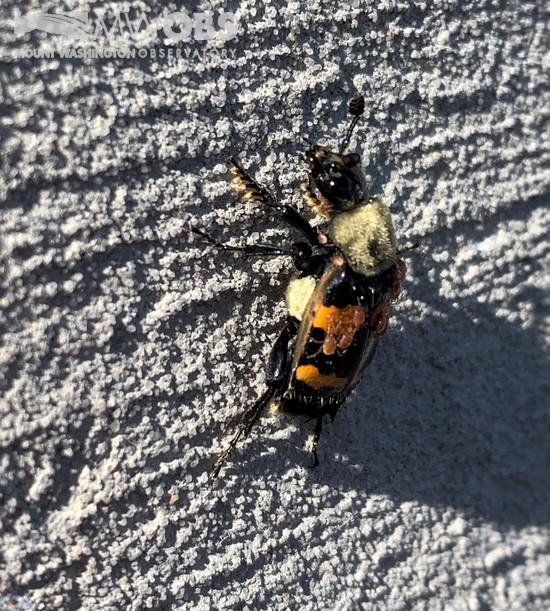Can I Bug You for a Minute? (Identifying an Insect on Mount Washington)
2019-09-21 09:37:56.000 – Tom Padham, Weather Observer/Education Specialist
While enjoying a beautiful afternoon on the top of the tower I stumbled upon an interesting looking beetle and decided to take a photo just for fun. It was a picture perfect day with light winds and I was actually painting the very top of our tower, taking advantage of the rare, nearly calm wind conditions on Thursday. I’m very glad I stopped to take this photo. After doing a little bit of research to identify the species and inspect the photo further it turned out to be a fascinating (if not a little gross) story learning about the life of this bug!

After doing a bit of background research, I am fairly certain this beetle species is Nicrophorus Tomentosus, or the Tomentose Burying Beetle. The beetle does look a little similar to a bumble bee, likely as a way of discouraging it from being eaten by birds or small mammals. This is a species of carrion beetle, usually found lower down in the forests of eastern North America. Burying beetles bury or cover the small remains of animals like birds and rodents, and help to clean up the forest floor in a way. They reproduce and lay eggs near a newly found carcass after secreting a fluid that actually inhibits the growth of mold and bacteria, which would compete with the development of their larvae.
Fascinating and gross at the same time I realize, but wait, there’s more! Take a closer look at the photo of the beetle. Along portions of the head and abdomen (thorax) there’s several small orange shaped mites! Initially I did not even notice these, and then when I did I thought they must be parasitic to the beetle. It turns out this is almost the opposite of the truth!
These small mites actually have a bit of a symbiotic relationship with the beetle, where both parties gain from the presence of the other. The mites mostly feed on the eggs of flies and maggots that are located around carrion, and compete with the beetle larvae. The mites and beetles work together to clear off the carcass of these competitors, and basically contain the carcass into a small little pit that the beetles dig out and cover. The mites then hitch a ride on the beetle, since the beetles can fly and otherwise the mites would have a pretty tough time moving from one place to the next.
I find it always fascinating learning about the natural environment and how sometimes very small creatures can have such an elaborate story to tell. It always helps to take a moment to stop and look around, and I’m certainly glad I did this time. Thanks for reading and sorry if I bugged you (or grossed you out) for just a minute!
Tom Padham, Weather Observer/Education Specialist
From Weather Observer to Intern, to Observer Again
From Weather Observer to Intern, to Observer Again By Madelynn Smith As I rode in the backseat of our Obs van up the Auto Road for the first time as a full-time employee at
From Mountains to More Mountains
From Mountains to More Mountains: This Time with Stronger Winds By Alyssa Bélanger On the observation deck in high winds. Hello there! My name is Alyssa Bélanger and I am a fall
From Summit to Sign-Off: My Farewell to the Rockpile
From Summit to Sign-Off: My Farewell to the Rockpile By Amy Cotter Enjoying my last Mount Washington sunset (for now) on September 13, 2025. After two incredible years with the Mount Washington




